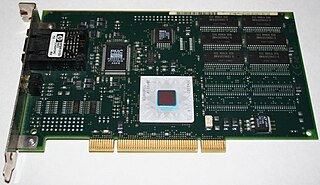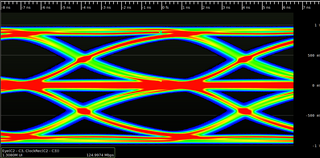Related Research Articles

Asynchronous Transfer Mode (ATM) is a telecommunications standard defined by American National Standards Institute (ANSI) and ITU-T for digital transmission of multiple types of traffic. ATM was developed to meet the needs of the Broadband Integrated Services Digital Network as defined in the late 1980s, and designed to integrate telecommunication networks. It can handle both traditional high-throughput data traffic and real-time, low-latency content such as telephony (voice) and video. ATM provides functionality that uses features of circuit switching and packet switching networks by using asynchronous time-division multiplexing.

Integrated Services Digital Network (ISDN) is a set of communication standards for simultaneous digital transmission of voice, video, data, and other network services over the digitalised circuits of the public switched telephone network. Work on the standard began in 1980 at Bell Labs and was formally standardized in 1988 in the CCITT "Red Book". By the time the standard was released, newer networking systems with much greater speeds were available, and ISDN saw relatively little uptake in the wider market. One estimate suggests ISDN use peaked at a worldwide total of 25 million subscribers at a time when 1.3 billion analog lines were in use. ISDN has largely been replaced with digital subscriber line (DSL) systems of much higher performance.
In telecommunication and electronics, baud is a common unit of measurement of symbol rate, which is one of the components that determine the speed of communication over a data channel.
Digital subscriber line is a family of technologies that are used to transmit digital data over telephone lines. In telecommunications marketing, the term DSL is widely understood to mean asymmetric digital subscriber line (ADSL), the most commonly installed DSL technology, for Internet access.
The S interface or S reference point, also known as S0, is a user–network interface reference point in an ISDN BRI environment, characterized by a four-wire circuit using 144 kbit/s (2 bearer and 1 signaling channel; 2B+D) user rate.

In computer networking, Fast Ethernet physical layers carry traffic at the nominal rate of 100 Mbit/s. The prior Ethernet speed was 10 Mbit/s. Of the Fast Ethernet physical layers, 100BASE-TX is by far the most common.

Basic Rate Interface or Basic Rate Access is an Integrated Services Digital Network (ISDN) configuration intended primarily for use in subscriber lines similar to those that have long been used for voice-grade telephone service. As such, an ISDN BRI connection can use the existing telephone infrastructure at a business.
Two-binary, one-quaternary (2B1Q) is a line code used in the U interface of the Integrated Services Digital Network (ISDN) Basic Rate Interface (BRI) and the high-bit-rate digital subscriber line (HDSL). 2B1Q is a four-level pulse-amplitude modulation (PAM-4) scheme without redundancy, mapping two bits (2B) into one quaternary symbol (1Q). A competing encoding technique in the ISDN basic rate U interface, mainly used in Europe, is 4B3T.
In the seven-layer OSI model of computer networking, the physical layer or layer 1 is the first and lowest layer; The layer most closely associated with the physical connection between devices. This layer may be implemented by a PHY chip.
B channel (bearer) is a telecommunications term which refers to the ISDN channel in which the primary data or voice communication is carried. It has a bit rate of 64 kbit/s in full duplex.
The ISDN User Part or ISUP is part of Signaling System No. 7 (SS7), which is used to set up telephone calls in the public switched telephone network (PSTN). It is specified by the ITU-T as part of the Q.76x series.
The media-independent interface (MII) was originally defined as a standard interface to connect a Fast Ethernet media access control (MAC) block to a PHY chip. The MII is standardized by IEEE 802.3u and connects different types of PHYs to MACs. Being media independent means that different types of PHY devices for connecting to different media can be used without redesigning or replacing the MAC hardware. Thus any MAC may be used with any PHY, independent of the network signal transmission media.
ANSI T1.413 is a technical standard that defines the requirements for the single asymmetric digital subscriber line (ADSL) for the interface between the telecommunications network and the customer installation in terms of their interaction and electrical characteristics. ADSL allows the provision of voiceband services including plain old telephone service (POTS) and data services up to 56 kbit/s, and a variety of digital channels. In the direction from the network to the customer premises (downstream), the digital bearer channels may consist of full-duplex low-speed bearer channels and simpler high-speed bearer channels; in the other (upstream) direction, only low-speed bearer channels are provided.

MLT-3 encoding is a line code that uses three voltage levels. An MLT-3 interface emits less electromagnetic interference and requires less bandwidth than most other binary or ternary interfaces that operate at the same bit rate, such as Manchester code or Alternate Mark Inversion.
Carrierless amplitude phase modulation (CAP) is a variant of quadrature amplitude modulation (QAM). Instead of modulating the amplitude of two carrier waves, CAP generates a QAM signal by combining two PAM signals filtered through two filters designed so that their impulse responses form a Hilbert pair. If the impulse responses of the two filters are chosen as sine and a cosine, the only mathematical difference between QAM and CAP waveforms is that the phase of the carrier is reset at the beginning of each symbol. If the carrier frequency and symbol rates are similar, the main advantage of CAP over QAM is simpler implementation. The modulation of the baseband signal with the quadrature carriers is not necessary with CAP, because it is part of the transmit pulse.
4B3T, which stands for 4 (four) binary 3 (three) ternary, is a line encoding scheme used for ISDN PRI interface. 4B3T represents four binary bits using three pulses.
High-bit-rate digital subscriber line (HDSL) is a telecommunications protocol standardized in 1994. It was the first digital subscriber line (DSL) technology to use a higher frequency spectrum over copper, twisted pair cables. HDSL was developed to transport DS1 services at 1.544 Mbit/s and 2.048 Mbit/s over telephone local loops without a need for repeaters. Successor technology to HDSL includes HDSL2 and HDSL4, proprietary SDSL, and G.SHDSL.

ITU-T Recommendation G.709Interfaces for the Optical Transport Network (OTN) describes a means of communicating data over an optical network. It is a standardized method for transparent transport of services over optical wavelengths in DWDM systems. It is also known as Optical Transport Hierarchy (OTH) standard. The first edition of this protocol was approved in 2001.
References
- ↑
 This article incorporates public domain material from Federal Standard 1037C. General Services Administration. Archived from the original on 2022-01-22.
This article incorporates public domain material from Federal Standard 1037C. General Services Administration. Archived from the original on 2022-01-22. - 1 2 3 4 5 6 Burd, Nick (1997). "Section 4.5: U interface standards". ISDN Subscriber Loop. London: Chapman & Hall. ISBN 9780412497308.
- ↑ Kessler, Gary C. (1997). ISDN : concepts, facilities, and services. Internet Archive. New York : McGraw-Hill. p. 98. ISBN 978-0-07-034249-1.
- ↑ Kessler, Gary C. (1997). ISDN : concepts, facilities, and services. Internet Archive. New York : McGraw-Hill. p. 104. ISBN 978-0-07-034249-1.
- ↑ Kessler, Gary C. (1997). ISDN : concepts, facilities, and services. Internet Archive. New York : McGraw-Hill. p. 312. ISBN 978-0-07-034249-1.
- ↑ Kessler, Gary C. (1997). ISDN : concepts, facilities, and services. Internet Archive. New York : McGraw-Hill. p. 300. ISBN 978-0-07-034249-1.
- 1 2 "ETR 080: Digital transmission system on metallic local lines" (PDF). ETSI. November 1996. Archived (PDF) from the original on 2022-10-09. Retrieved 2014-01-17.
- 1 2 3 "T1E1.4/98-004R2 DRAFT ANSI T1.601-1998: Integrated Services Digital Network (ISDN) Basic Access Interface for Use on Metallic Loops for Application on the Network Side of the NT (Layer 1 Specification)" (PDF). ANSI. 1998. Archived (PDF) from the original on 2022-10-09. Retrieved 2014-01-17.
- 1 2 3 4 5 6 7 8 9 10 11 12 13 14 15 16 17 18 19 20 21 22 23 24 25 26 27 28 29 30 31 32 33 34 35 "G.961: Digital transmission system on metallic local lines for ISDN basic rate access". ITU-T. March 1993. Retrieved 2014-01-06.
- ↑ Inoue, O. (August 1992). "Implementation in Japan (ISDN)". IEEE Communications Magazine. IEEE. 30 (8): 54–57. doi:10.1109/35.149619.